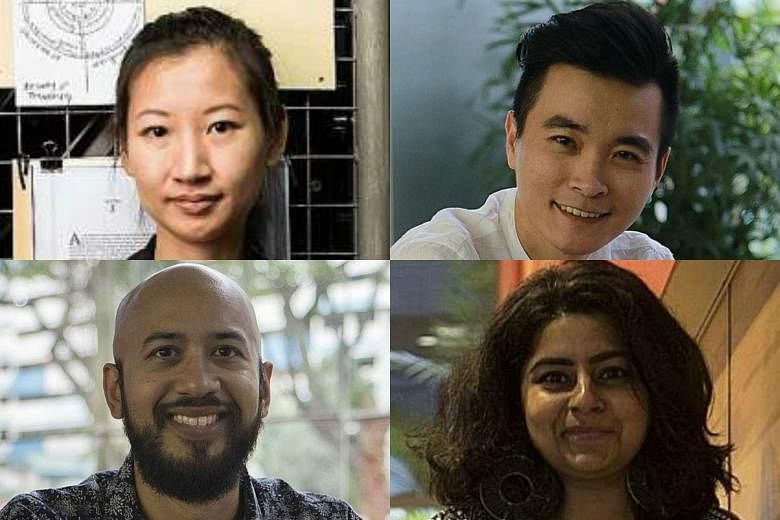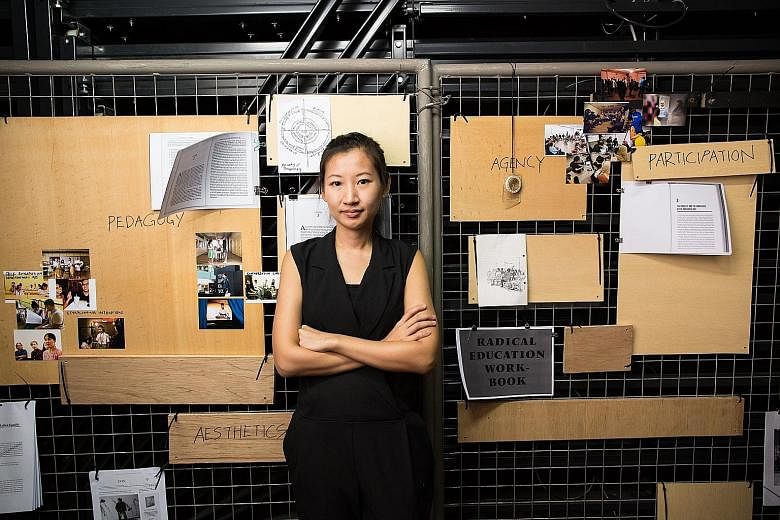ALECIA NEO, 30

Relationships are at the heart of Alecia Neo's work. The photographer creates installations that lets viewers experience life through someone else's eyes.
Her debut project, Villa Alicia (2011), allowed the public into the soon-to-be-demolished home of late Singaporean feminist Nalla Tan. It was an intimate encounter with Dr Tan's history and her battle with Alzheimer's disease.
Neo says: "The work was important because she was a critical and strong voice for women in society, and her voice had been largely forgotten. For me, the work came alive through the audience's presence and the meaning they derived from their experience in the space and the meeting of others."
Most striking are her Unseen series of photographs. The first was showcased at the M1 Fringe in 2013 and led viewers into the everyday world of visually impaired people in Singapore and Taipei.
In 2014, the Singapore Art Museum commissioned her to create Unseen: Touch Field, a sensory experience that included Braille drawings, sound and video.
And last year, Objectifs Gallery showcased Unseen: Constellations. Visually disabled students under Neo's guidance created immersive experiences to share their hopes and dreams.
Neo says: "I would like to think of myself as an artist working with people. Relationships are at the heart of all the work that I do."
No wonder, given her upbringing. Her father owns a hardware store and she grew up "watching him build a community around his work". Her housewife mother influenced her with the thought and care with which she relates to people.
Neo studied at Nanyang Technological University's School of Art, Design and Media. She has also done overseas residencies, including in Biella, Italy.
She plans to use the grant of up to $20,000 from the Young Artist Award for a new project about education and climate change. She wants to start people thinking about "excessive consumption and waste, which are largely invisible in our daily life".
She adds: "I am most interested in understanding how an artist can potentially contribute in generating shifts or transformation in society through negotiating difference."
Akshita Nanda
LIU XIAOYI, 35

Liu Xiaoyi's theatrical experiments with time and space range from the award-winning to the challenging. Last year, he won Best Original Script at the M1-The Straits Times Life Theatre Awards for his 2014 play Fluid, crafted as a radio play.
This August, during the M1 Chinese Theatre Festival, his sketches Descendants 600 and Descendants 400 had actors move incredibly slowly over 20-minute spans of time. One audience member pulled his jacket over his head for a snooze.
Liu laughs. "That's a common reaction to my shows. I'm okay with it," he says. "I know audiences like narratives, but I'm interested in time and space and body."
To illustrate what he wants to do with theatre, he opens an ever-present notebook. He draws a moving stick figure, bordered by a frame and then stepping out of it.
China-born Liu's innovations are shaping experimental theatre in Singapore today. The permanent resident moved here from Chaozhou in 1998. At age 19, he was taken under the wing of The Theatre Practice, the troupe founded by the late Kuo Pao Kun. To him, the place is home, and artistic director Kuo Jian Hong the mentor who believed in him. Liu is married to a China-born permanent resident.
Today, he is director of The Theatre Practice's Practice Lab, which was set up three years ago for experimental works. He has multiple Life Theatre Award nominations for Best Script and Best Director.
His work sometimes revises the troupe's legacy. Last year, he resurrected Kuo's 1969 play The Struggle, about a group of workers exploited by their employer, which was banned by the authorities when it was first staged.
He hopes to use the Young Artist Award for training and research for future projects.
He is interested in reworking traditional Asian art forms such as Kun opera, examining it through the one table, two chairs minimalist setting. He will present one such piece in Tokyo this month.
Then there is Uproot, a collaborative performance running this week and for which the script is a collection of timed sounds and movements. "Is this theatre?" Liu asks, showing off the script.
Some might argue it is performance or visual art. "I've been told to show my works in a museum," he says, laughing again.
Akshita Nanda
MUHAMAD HAREZAM, 35

Muhamad Harezam's ethereal flesh-coloured creations of tiny animal fossils or delicate flowers delight and disturb. The artist, known as Ezzam Rahman, sculpts them from dead skin.
There are several reasons behind this choice of material. He enjoys unconventional visual aesthetics and getting viewers to question the idea of impermanence. He adds: "I have no studio, so I can't make big sculptures."
The use of his body is also important to him as a performance artist. In You Have To Know Me To Love Me, showcased during Singapore Design Week last year, he breathed out white powder and had viewers move through a layer of it to explore addiction.
In August last year, he tied with artist Ong Kian Peng in winning the Grand Prize for the President's Young Talents award. More of his skin sculptures were showcased at the Singapore Art Museum, along with his performance art. He was also awarded the People's Choice Award by the museum, yet news of this year's Young Artist Award came as a shock to him.
"When the National Arts Council called, I didn't believe it at first," he says. Why? Because he is a late bloomer who failed his N levels twice, sat his O levels at age 18 and started at Lasalle-SIA College of the Arts only when he was about 20 years old.
His artistic inclinations were difficult for his family to understand. His late father, a truck driver who died six years ago, would have been scandalised by his collecting dead skin for his art. As for his housewife mother, he says: "She's seen the process, she's never quite liked it."
The middle of three brothers, Ezzam had a difficult teenhood. The one saving grace was his art teacher Larry Wong, who inspired him to follow his dreams.
For that reason, Ezzam teaches at Lasalle and has plans for a career in education.
"I hope I can be a role model and example for one young future artist who is hungry and has a passion for the arts. If I can erase my high school days, I'd like to erase everything except the quiet moments I spent in the art room with the teacher."
Trained as a sculptor at Lasalle, he has a bachelor's degree in fine arts from the University of Huddersfield, and is almost done with his master's in fine arts from Goldsmiths, University of London at the Lasalle campus.
Akshita Nanda
MARC NAIR, 34

When Marc Nair - "the poet with the beard" - tells people what he does, he draws shocked gasps.
"People are like, 'Huh? Got ah? You know ah, I've never met a real poet before in Singapore. Wah, very honoured,'" he says with a laugh.
His life-long passion for poetry was sparked by a childhood obsession with nursery rhymes, which he would memorise and recite to his mother. It was a foreshadowing of his contributions to the art scene.
Now, he is still as "hopelessly in love" with words as he was as a young boy, writing for both the page and the stage. He has six poetry collections under his belt.
He says of the award: "I see it as a recognition of spoken word, which in Singapore is still an art form that people don't know about. It's like it has gained a certain kind of mainstream acceptance."
He was the artistic director from 2011 to 2014 of Lit Up Singapore, a multi-disciplinary arts festival, and has performed at major events, such as the Singapore Poetry Slam, and represented Singapore in international competitions, such as the 2009 World Poetry Slam in Paris.
"I love that in spoken word you have an immediate audience for your words. You can shape the energy in a room, control how people receive your words," he says.
"You're a performer, but you're also a poet. You wield words. Great orators understand the power there is in words, but you're not using it to push an agenda. You're using it to show how beautiful language can be."
He is a 2016-2017 Nanyang Technological University-National Arts Council writer-in-residence and is working on a new collection tentatively titled FieldNotes.
He also conducts spoken-word workshops for secondary school and junior college students.
"It's so important to keep an awareness of local literature and the need for stories in our pragmatic lives," he says.
Nair explores a range of topics, from pop culture to his experiences. His latest book Spomenik - launched in March - is a collection of poems and photographs he took on a trip around the Balkans.
One of the destinations he plans to hit for his future works is Cuba - and he is hoping to tap the award grant for the trip.
"It's a place that was stuck in time and now that it's opening up, I would like to go before the world gets grubby with it," he says.
Nur Asyiqin Mohamad Salleh
POOJA NANSI, 34

At just three years old, Pooja Nansi knew she wanted to be a teacher, lining her dolls up and giving them lessons.
And growing up surrounded by stories and music she fell head-overheels for poetry, "the natural marriage of rhythm and rhyme".
As an adult, she made time for both writing and teaching, finding her own voice even as she helped her students figure out theirs and kindle their love of literature.
"Being a writer made me a better teacher because I went into the classroom knowing that writing poetry or literature is relevant. It made me teach it with a kind of immediacy," says Nansi, who taught at Temasek Junior College for nine years, 21/2 of them as head of language arts and English literature.
Nansi, who now teaches creative writing part-time at Nanyang Technological University, has put out two poetry collections, Love Is An Empty Barstool (2013) and Stiletto Scars (2007).
She also co-authored teaching guide Local Anaesthetic: A Painless Approach To Singaporean Poetry (2014) and has flown the Singapore flag at international arts events such as the Ubud Writers & Readers Festival.
Part of spoken word and music duo Mango Dollies, she has since April 2013 been curating a monthly spoken word and poetry showcase at Artistry in Jalan Pinang called Speakeasy, showcasing established poets and unearthing new talents.
"As a teenager, I used to write poems about boys I had crushes on, silly things like that," she recalls with a laugh. "But then in university, I went to my first poetry slam."
It was held in Velvet Underground at Zouk. The atmosphere, she remembers, was electric.
"The slam was when I started thinking about poetry as something living and breathing - not just lying flat in a book for you to read, but also something that you could really experience as a life form."
She says one of the things she hopes to do with the award grant is to create some time and space to explore issues that people may find difficult to talk about, among them what it means to be a minority in Singapore.
"It's doubly interesting for me because I'm a first-generation Singaporean. My parents came here as immigrants from India and I've been here since I was a year old.
"I think there's a lot of stories to be told about these experiences, which we don't read much about. It's not about creating dissent or anything, but recognising that people's experiences of living in Singapore are different."
Nur Asyiqin Mohamad Salleh






